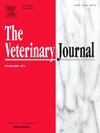骆驼和驴中的施马伦贝格病毒暴露:尼日利亚-萨赫勒地区跨界传播的潜在宿主。
IF 3.1
2区 农林科学
Q1 VETERINARY SCIENCES
引用次数: 0
摘要
牲畜贸易和迁移模式的改变影响了跨界动物疾病的传播。施马伦贝格病毒(Schmallenberg virus, SBV)是一种通过蚊虫传播的新型虫媒病毒病原体,可导致反刍动物严重的出生缺陷和流产、短暂发热、腹泻和产奶量减少,是对家畜种群的全球性威胁。本研究调查了骆驼和驴对SBV的暴露情况,并确定了可能影响SBV传入和传播的潜在危险因素。采用商用酶联免疫吸附试验(ELISA)对460份骆驼(n=230)和驴(n=230)血清样本进行SBV抗体筛选,并收集潜在危险因素数据。观察到的SBV血清阳性率在骆驼中为56.5%,在驴中为11.3%。单因素分析显示,老年骆驼的血清患病率显著高于老年骆驼(P = 0.008,优势比(OR) = 2.3;95%可信区间(CI): 1.25-4.27)和驴(P = 0.004; OR = 3.41; 95% CI: 1.48-7.97)。血清阳性率不受性别、管理制度和混种饲养的显著影响。多变量分析显示了感染风险的地理聚类性,Zangon Daura的骆驼(OR = 4.73; 95% CI: 1.33-20.4)和Sule Tankarkar的驴(OR = 4.46; 95% CI: 1.20-17.9)的血清阳性几率显著较高。我们的研究结果表明,骆驼和驴子暴露于SBV,可能是该地区传播的水库和潜在来源。建议进一步的分子研究,以更深入地了解SBV传播动力学。本文章由计算机程序翻译,如有差异,请以英文原文为准。
Schmallenberg virus exposure in camels and donkeys: Potential reservoirs for trans-border spread in the Nigeria-Sahel region
Livestock trade and altered migration patterns have influenced the spread of transboundary animal diseases (TADs). Schmallenberg virus (SBV), an emerging arboviral pathogen transmitted by biting midges, causes severe birth defects and abortions, transient fever, diarrhea, and reduced milk production in ruminants, exemplifying a global threat to domestic livestock populations. This study investigated the exposure of camels and donkeys to SBV and identified potential risk factors that may influence introduction and spread. A total of 460 serum samples from camels (n = 230) and donkeys (n = 230) were screened for SBV antibodies using a commercial enzyme-linked immunosorbent assay (ELISA), and data on potential risk factors were collected. The observed seroprevalence of SBV was 56.5 % in camels and 11.3 % in donkeys. Univariate analysis demonstrated a significantly higher seroprevalence in older camels (P = 0.008; odds ratio (OR) = 2.3; 95 % confidence interval (CI): 1.25–4.27) and donkeys (P = 0.004; OR = 3.41; 95 % CI: 1.48–7.97). Seropositivity was not significantly influenced by sex, management system, or mixed species rearing. Multivariable analysis revealed geographic clustering of infection risk, with significantly higher odds of seropositivity in camels from Zangon Daura (OR = 4.73; 95 % CI: 1.33–20.4) and donkeys from Sule Tankarkar (OR = 4.46; 95 % CI: 1.20–17.9). Our findings suggest that camels and donkeys are exposed to SBV and might serve as reservoirs and potential sources for spread within the region. Further molecular studies are recommended for a deeper understanding of SBV transmission dynamics.
求助全文
通过发布文献求助,成功后即可免费获取论文全文。
去求助
来源期刊

Veterinary journal
农林科学-兽医学
CiteScore
4.10
自引率
4.50%
发文量
79
审稿时长
40 days
期刊介绍:
The Veterinary Journal (established 1875) publishes worldwide contributions on all aspects of veterinary science and its related subjects. It provides regular book reviews and a short communications section. The journal regularly commissions topical reviews and commentaries on features of major importance. Research areas include infectious diseases, applied biochemistry, parasitology, endocrinology, microbiology, immunology, pathology, pharmacology, physiology, molecular biology, immunogenetics, surgery, ophthalmology, dermatology and oncology.
 求助内容:
求助内容: 应助结果提醒方式:
应助结果提醒方式:


